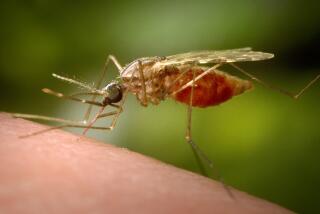Rodent of the Week: Chemical may cure malaria
- Share via
Malaria kills about 1 million people worldwide each year, often babies and children. Malaria drugs are available, but the parasites can become resistant to them, and new drugs are sorely needed.
Progress was reported this week on one such compound. Researchers found that a substance dubbed NITD609 cleared malaria-causing parasites in mice in a single, oral dose.
The discovery of the compound came about because of a massive screening project funded by the National Institute of Allergy and Infectious Diseases to look for substances that killed the most deadly malaria parasites. After zeroing in on a compound called NITD, scientists were able to synthesize a form of the compound and formulate it into a tablet. The drug is in a class of chemicals called spiroindolones.
“From the beginning, NITD609 stood out because it looked different, in terms of its structure and chemistry, from all other currently used antimalarials,” Elizabeth A. Winzeler, a co-investigator of the study and researcher at the Scripps Research Institute, said in a news release. “The ideal new malaria drug would not just be a modification of existing drugs, but would have entirely novel features and mechanisms of action.” The new compound fulfills that criteria, she added.
In the study, five mice that received a single, large dose of NITD609 were cured of the parasite while half of the six mice that received a smaller single dose were cured of active infection. Usually rodents infected with the particular mouse malaria parasite used in the study die within a week.
Researchers hope the medication, if proven successful in humans, might work with just a single dose in order to ease administration and treatment compliance. Studies in humans could begin later this year. The study was published Friday in the journal Science.
-- Shari Roan / Los Angeles Times
Return to Booster Shots blog.





